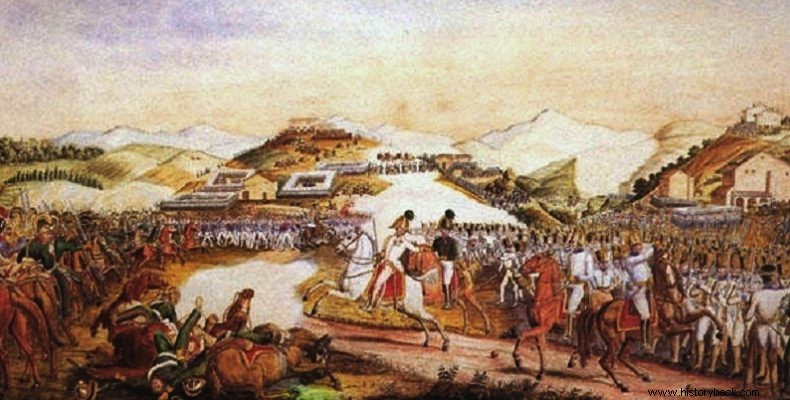
On March 15, 1815, Marshal Joachim Myra, king, still in the Kingdom of Naples, decided to change camp again and turn against his new allies and in favor of Napoleon who had escaped from the island of Elba. Myra had been installed as king in the southern Italian kingdom of Naples by Napoleon, whom he betrayed in 1813 by allying with his enemy.
However, after the defeat of 1814 and the abdication of Napoleon, Myra realized that despite his treachery France's allied rivals did not intend to leave him on his throne. This was also the reason Myra changed sides again.
After gathering around 50,000 men Myra moved north and soon occupied much of the Italian peninsula reaching the Po River and besieging Ferrara, hoping to rouse the Italians against the Austrians. The Austrians responded by mobilizing about 35,000 men, gradually. Myra failed to win the sympathy of the Italians and on April 8-9 he was bitterly defeated in his attempt to cross the Po, at Okiobelo . After this Myra retreated covered by strong rearguards.
Toward the decisive conflict
Myra retreated beyond Tolentino (about 40 km southwest of Ancona) where he gathered 25,000 men and 58 guns. With these forces he believed that he could easily defeat the Austrian corps of General Friedrich Bianchi who had only 13,000 men and 28 guns . Myra hoped to maneuver on interior lines, and after defeating Bianchi to turn against the other Austrian corps, Neuberg, which was also moving south.
Bianchi possessed a light brigade (, engineer company, 1,000 elite snipers Hunters, 400 Grenzner mountain guards, 440 hussars, a horse artillery with 6 light guns), 9 line infantry battalions, two field artillery battalions each of 8 guns, a strong Grenz battalion (970 men) and a Tuscan "brigade" with 726 cavalry and a horse artillery with 6 light guns.
On the other hand Myra possessed his mixed guard division of 3,330 infantry, 1,300 cavalry and 20 guns, the 2nd Infantry Division (8,000 infantry, 10 guns), the 3rd MP (7,900 infantry, 10 guns), the 4th MP (1,900 infantry, 500 cavalry) and the Cavalry Division (about 1,800 horsemen). Myra had another division at his disposal which he ordered to move independently and monitor Nyberg's corps.
On the 29th the Austrian hussars captured Tolentino, putting the Italian garrison to flight. Myra then stationed himself at Macerata and prepared for the attack. Bianchi, having perceived the intentions of his adversary, decided in his turn to defend the site of Tolentino, although his forces were outnumbered by the enemy, hoping to gain time to reach the area and his body Nyberg and surround Myra's army. So he ordered his forces to a series of strongholds in the area, the tower of Katervos, the old castle of Rancia, the churches of Maesta and Saint Joseph, the village of Polenta.
The illusory image of victory...
The battle began on May 2, 1815. Myra's forces attacked with vigor and even captured Bianchi for a few minutes, as the Austrian hussars, with a counterattack, freed him. After heavy cannonading Myra's men marched against Polenta and the castle of Rancia. Incredible scenes of heroism and carnage unfolded there. Both strongholds changed hands several times with the dead piling up in and around them. At the end of the day, however, the Austrians prevailed.
But Myra had no intention of resigning. The next day, May 3, the cannon boomed again signaling the start of the second day of battle. This time the Italians managed to capture the castle of Rancia and the nearby heights of Cantagalo, suffocating the Austrian left flank. But where the victory seemed certain, the tragic mistake happened...
The Italians, fearing an attack by the approaching Austrian cavalry stopped their infantry attack and formed squares. In doing so, however, they not only gave the Austrian infantry time to regroup, but allowed the Austrians to open a deadly fire on them – the squares were ideal targets due to their size – with every available weapon and cannon. At the same time that the Italian squares began to be broken up by fire, the Austrians, under the excellent general Johann Friedrich von Mohr , forced the Italians to retreat in the center and on their right flank.
Myra had been defeated. The seal was not the news brought to him by a messenger that the division he had detached to watch Nyberg had also been defeated. Fearing he would be encircled, he ordered a retreat which soon led to the complete disbandment of his army due to the rumor that British forces had landed in his rear.
In the two-day battle, the Austrians lost 800 men, against 4,120 of their opponents. But as mentioned Myra's army was disbanded as thousands of men deserted after the defeat. However, Myra managed to escape to Corsica. He tried to return to Napoleon's service before Waterloo, but the emperor did not accept the traitor.
Then Myra decided to recover the throne of Naples, counting on winning over the people against the Bourbon king Ferdinand who returned. But he failed miserably, he was captured and executed on October 13, 1815. He died bravely refusing to be blindfolded and giving the command "Fire" himself, asking the soldiers to aim at his heart and not his face...
